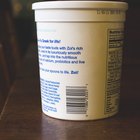
Freezing is a quick and easy way to store leftovers, premade home-cooked meals and foods whose refrigerator expiration date is looming. However, certain foods -- such as those containing dairy products -- may taste less than desirable after a stint in the freezer. Mayonnaise and sour creams can separate when they are frozen. This can result in a defrosted casserole that may taste delicious, but retain a grainy texture and look from its time in the freezer. One alternative is to freeze the meal without the milk-based product.
Considerations
Freeze casseroles containing mayonnaise and sour cream only in a pinch, because the results are generally undesirable. If there are no stabilizers for the dairy in the recipe, add a small amount of flour or cornstarch to the mayonnaise or sour cream in the recipe to prevent separation when freezing. Quickly cool the dish before freezing to prevent overcooking, which can also affect the texture.
Storing
Store in the freezer only if necessary. If doing so, then freeze in the portions desired. One method of doing this is by lining a glass or metal baking dish with tinfoil and freezing, removing the dish and covering thoroughly in more foil when hard. If defrosting a casserole, always thaw it in the refrigerator at 40 degrees Fahrenheit or below, as leaving it at room temperature can encourage bacterial growth especially if it contains eggs or sour cream. A better method for storing a casserole is by covering it, keeping it in the refrigerator and consuming it all in three to four days.
Reheating
Reheat previously cooked and frozen meals to at least 165 degrees Fahrenheit, testing with a food thermometer, to destroy any bacteria. If you want to thaw before reheating, use the microwave on the low-power defrost power. However, cook the food right away, again to 165 degrees Fahrenheit, on high power to reheat.
Alternatives
Prepare several meals, uncooked, in advance for freezing and quick preparation once defrosted -- without the mayonnaise or sour cream that the recipe calls for. Omitting these ingredients allows the casseroles to be frozen and stored. Once you're ready to eat them, defrost the modified casserole in a fridge, set at 40 degrees Fahrenheit or below, the night before serving. Toss with the mayonnaise or sour cream required by the recipe and cook in the oven according to the original recipe.
Related Articles

Can You Make Chicken Fettuccine Alfredo ...

Freezing a Moussaka
Is Mayonnaise That Has Been Frozen Safe ...
Freezing a Dish With Sour Cream in It

FDA Food Storage Temperature Guidelines

How Long to Bake a Pre-Cooked Frozen ...

Can Scalloped Oysters Be Prepared Ahead?
How to Freeze a Baguette

Guidelines For Refreezing
Can Lasagna Be Preassembled With Egg As ...

How to Freeze Greek Yogurt
Can You Use Stew Meat That Has Been ...
How to Use Yogurt or Sour Cream Instead ...

Freezing a Moussaka

How to Store Cracked Eggs in ...

How to Substitute Cornstarch for ...

Can You Freeze Cream Cheese & Whipped ...

How Long Is Cooked Chicken Good?

How to Defrost Bulk Pork Sausage

If Meat Is Frozen, How Long Does It ...
References
Writer Bio
Based in Kingston, Canada, Samantha Lowe has been writing for publication since 2006. She has written articles for the "Mars' Hill" newspaper and copy for various design projects. Her design and copy for the "Mars' Hill" won the Associated Collegiate Press Pacemaker award in 2008. Lowe holds an Honors BA from Trinity Western University, and a MSc in Occupational Therapy from Queen's University where she is currently doing her PhD.
Photo Credits
Eising/Photodisc/Getty Images